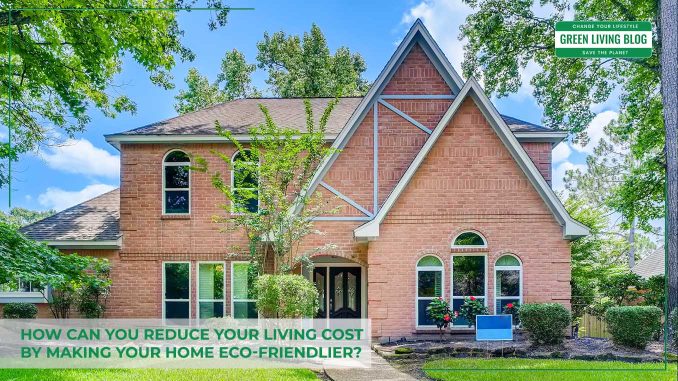
The cost-of-living crisis has impacted practically every household in the UK, as the rate of inflation remains high despite the Bank of England’s efforts to stifle its impact. Though the crisis is felt keenly in supermarkets and at the fuel pump, it is perhaps most keenly felt in household’s energy bill statements.
The crisis was largely caused by a sharp increase in the cost of wholesale energy in late 2021, which had severe knock-on effects on household energy prices in the long term. As such, millions of households are facing a winter of difficult decisions and delaying switching on their heating for as long as possible.
This is where the issue of eco-friendliness enters the equation. Far from a signal of virtue in a rapidly accelerating climate crisis, aiming for a lower household carbon footprint can actually help households manage through the economic crisis.
With the right energy-saving measures, you can keep your home warm with minimal active cost. But how might you make your home an eco-friendlier one, and cut your bills as a result? Read on!
1. Insulation

Insulation is the most fundamental measure you can take to improve the eco-friendliness of your home. Insulation ensures that heat does not escape, enabling you to remain comfortable for longer without switching on your home’s HVAC system. Insulation in your home also means when the heating is turned on, it will take significantly less time and energy to heat the home to the desirable temperature, then retaining that heat for longer amounts of time.
There are many ways in which you can approach insulating your home. Cavity wall insulation is the most impactful method, preventing heat from escaping through your external walls. There are also plumbing and heating interventions you can make, with pipe insulation ensuring heat is not lost through your home’s hot water pipes.
Similarly, loft and roof insulation are another must-have for an eco-friendly building, significantly reducing the amount of heat that is lost through the heat rising and escaping through an uninsulated roof.
Loft and roof insulation are essential for any eco-friendly building, helping to significantly reduce heat loss caused by rising warmth escaping through an uninsulated roof. Chris from Loft insulation Northern Ireland highlights its importance, stating, “Loft and roof insulation are a must-have for any eco-conscious property, as they play a key role in minimizing heat loss and improving energy efficiency.”
You should also ensure that sustainable materials are used for your home’s insulation.
2. Heating Systems

Speaking of your home’s heating system, this in and of itself can represent a large and unnecessary portion of your household’s carbon footprint. Older boilers are much more inefficient than modern alternatives, and the central heating combi boiler – an improvement as it is on older conventional boiler systems – is still a major producer of CO2.
Replacing your central heating with an energy-efficient alternative such as heat pumps can have a profound impact on the overall carbon footprint of your home. The government has instituted a Green Homes Grant to help homeowners make the switch, offering up to £5,000 towards the cost of installing a biomass boiler or a ground- or air-source heat pump.
3. Double Glazing

Double glazed windows are not a particularly new invention and are a standard provision in newer-build homes across the UK. However, there remain many older homes that still have sash or pane windows. A single pane of glass can act as a conduit for heat, accelerating heat loss in an older home. They are also often poorly sealed, leading to an increase in draughts.
Double-glazed windows, though, are two tempered panes set apart by a vacuum. This vacuum acts as an insulating layer, preventing too much heat from dissipating through the windows and also adding a level of soundproofing to the property. If your home is an older home, it may be time to upgrade your windows.
Final Thoughts
Energy efficiency and eco-friendliness of buildings are key factors for both the sale value of properties, signifying a lower cost for heating bills, but also providing a more liveable and comfortable home for those living in the property, all while reducing the impact on the environment by reducing total energy consumption.
Hopefully, with the above tips, your home can save you money in the future and at the same time give something back to this planet.
![]()
Author Profile

- Eco Warrior by day, Eco Blogger by night trying to get the eco balance right.
Latest entries
 Green Home GuidesApril 17, 2025How Heat Pumps Help Cut Household Carbon Emissions
Green Home GuidesApril 17, 2025How Heat Pumps Help Cut Household Carbon Emissions EnvironmentApril 17, 20256 Benefits of Wall Cladding for Eco-Friendly Renovations
EnvironmentApril 17, 20256 Benefits of Wall Cladding for Eco-Friendly Renovations EnvironmentMarch 31, 20255 Sustainable Materials for Building Your Dream Eco-Friendly Pergola
EnvironmentMarch 31, 20255 Sustainable Materials for Building Your Dream Eco-Friendly Pergola Best practicesMarch 25, 202510 Green Tips to Live a More Sustainable Lifestyle
Best practicesMarch 25, 202510 Green Tips to Live a More Sustainable Lifestyle





Leave a Reply
You must be logged in to post a comment.